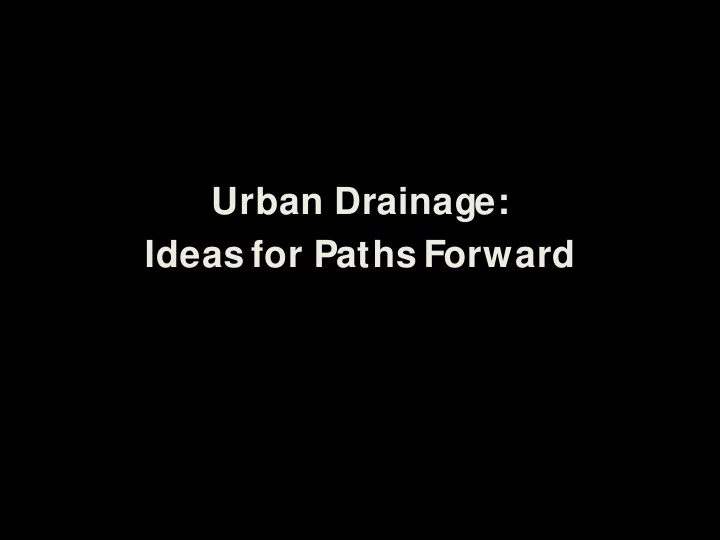

Urban Drainage: Ideas for Paths Forward
THE DOWNSCALING PROBLEM : One day in the 21st Century... (GFDL A2) Downscaled Original GCM values
THE DOWNSCALING PROBLEM : One day in the 21st Century... (GFDL A2) Urban drainage adaptations call for better downscaling * or* understanding of extreme precipitation events. Special requirements: • Extremes, not means! • Long enough realizations to support frequency analysis of rare events • Adequate representations of extreme-event meteorological processes & results Urban runoff models want: High temporal resolution High spatial resolution High precip resolution
1. History-based Vulnerability Analyses • Using existing data & stormwater models, map critical vulnerabilities of a city’s stormwater management systems • The question to climate analysts becomes “How likely are these breaking points to be reached in available climate-change projections & by common sense?” • Uses most-realistic, highest-res data • “ Simply” expands beyond standard design-storm methods • Infinite range of possibilities to be explored? • M inimal connections to specific clim-chg projections
2. Severe-Storm Condition Evaluations • Focus on the specific storm types that challenge the stormwater systems most (describing them in large-scale meteorological terms rather than “just” by intense precip) • The question to climate analysts becomes “What sort of changes are projected in frequency & intensity of these storm types?” • Focuses on best aspects of GCM s (general circulation models) • Natural extension of historical vulnerability analyses • Reduces range of possibilities to be explored • Direct connections to specific clim-chg projections, without undue belief in uncertain details
“ Semi-quantitative characterization” of a particular category of West Coast extreme storm events: Atmospheric Rivers in IPCC AR4 projections Obs case Water Vapor & 2046-2065 Low-Level Winds 1961-2000 2081-2100 Dettinger, in press, J AWRA
3. High-resolution Simulations and Downscaling • Continue along the developing path of “dynamical downscaling,” using advances in that field as they emerge • The question to climate analysts becomes “What precipitation extremes are projected at finest scales obtainable?” • Provides detailed examples of extremes that might be faced • Support may be necessary to ensure focus on stormwater-info needs (most focus remains on average changes) • Direct connections to specific clim-chg projections • Technology is still developing & expensive • Short simulations provide little basis for freq-analysis of rare extremes
Other research needs/ options: M assive-ensemble regional downscaling (RegCPDN) • Tens of thousands of years of simulations on 25-km grids, outputting (among other things): � M aximum daily P each year � 10-year maximum P within 3 Water Vapor & Low-Level Winds consecutive days � Constructed analogs Number of days with P > 3 downscaling thresholds over 10yr windows Statistical downscaling • M any advantages (speed, bias correction, … ) • Revisit/ revalidate/ redesign(?) statistical dscaling with extreme, rare events as focus
IPCC4 SRES scenarios vs. IPCC AR5 Representative Concentration Pathway (RCP) exemplars Notice that RCP8.5 is more extreme than A2 and by end of century more like A1Fi (see Dashed and slide #1) dotted curves are SRES A1b (IPCC4) “approximates” & solids are RCP6.0 RCP (IPCC5) scenarios B1 “approximates” RCP4.5 at this global- aggregated scale.
Recommend
More recommend